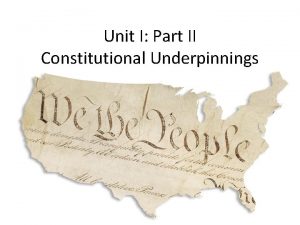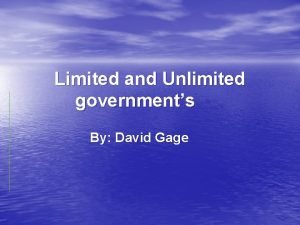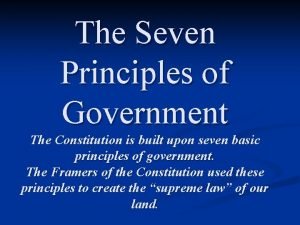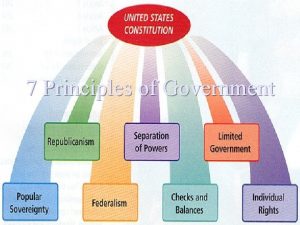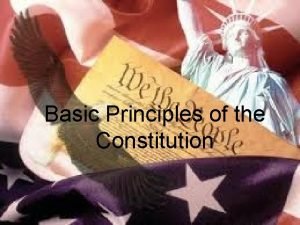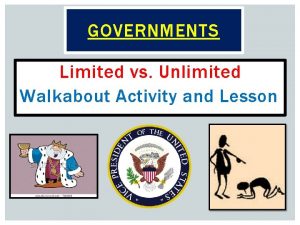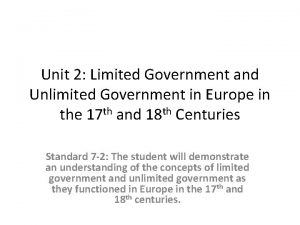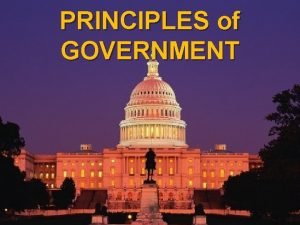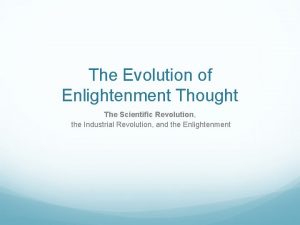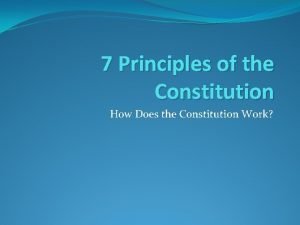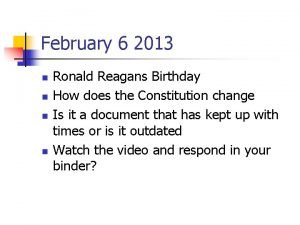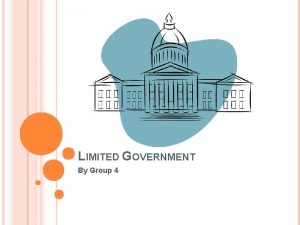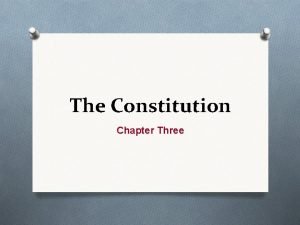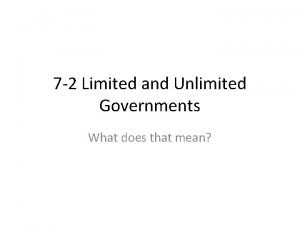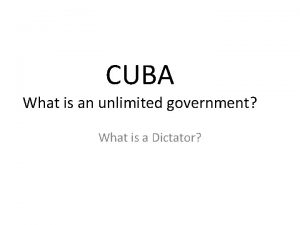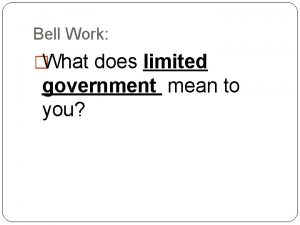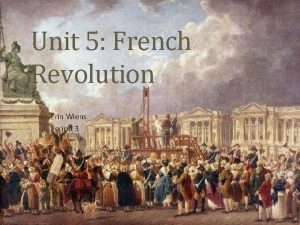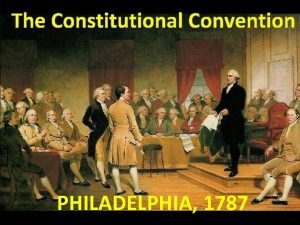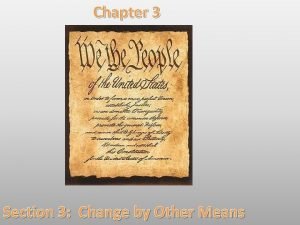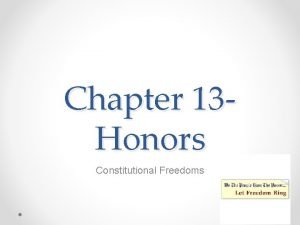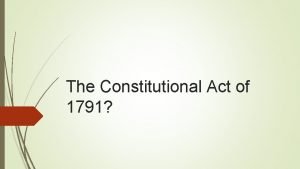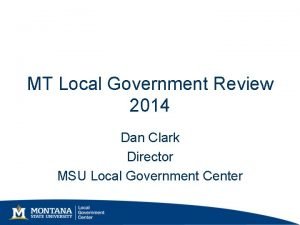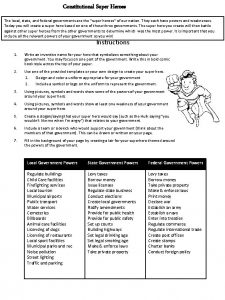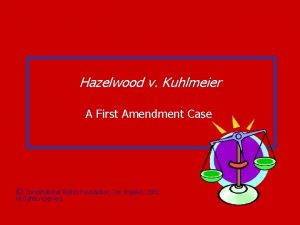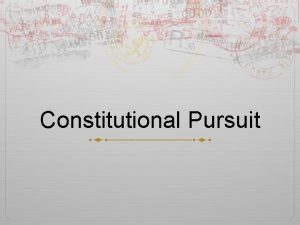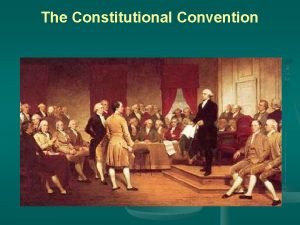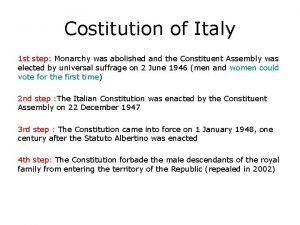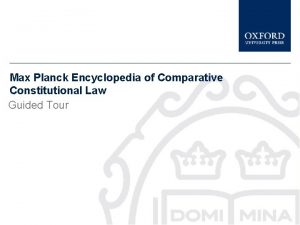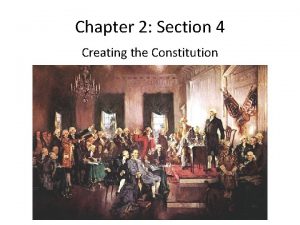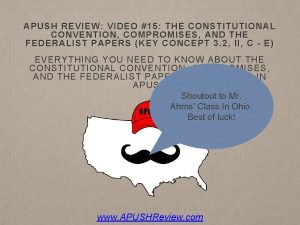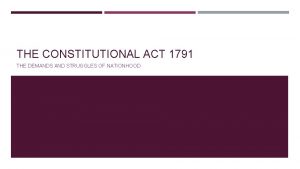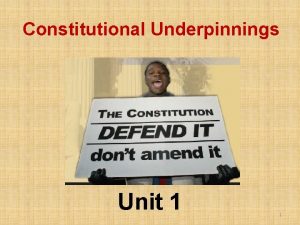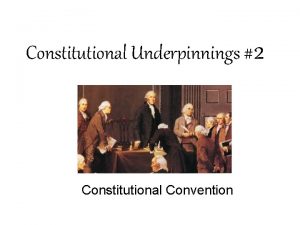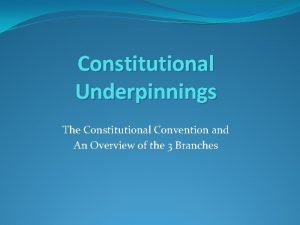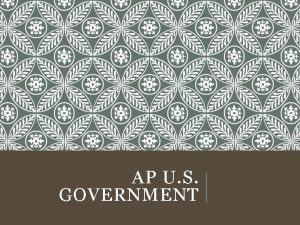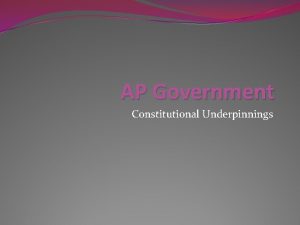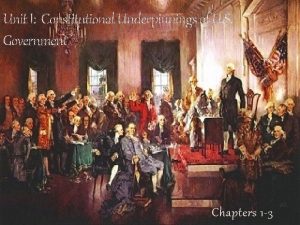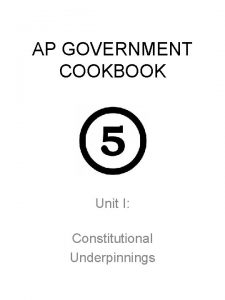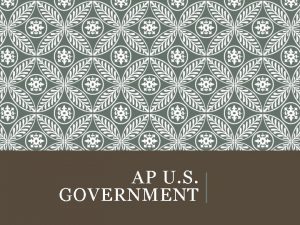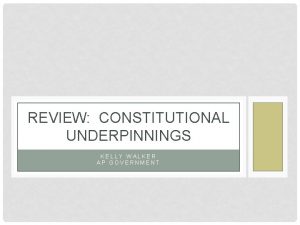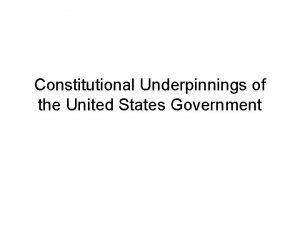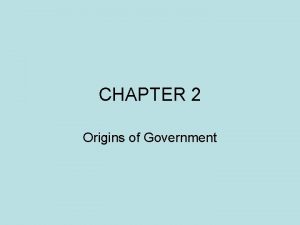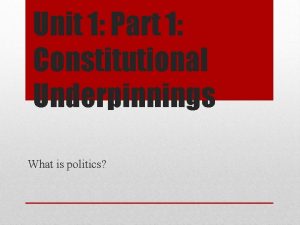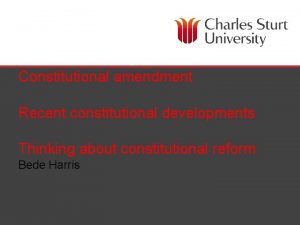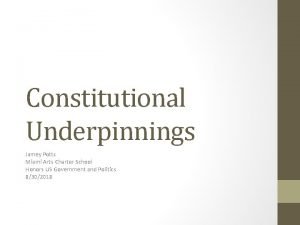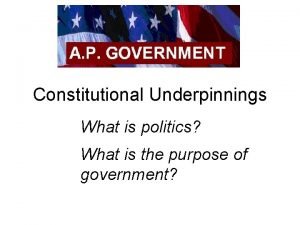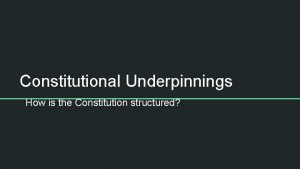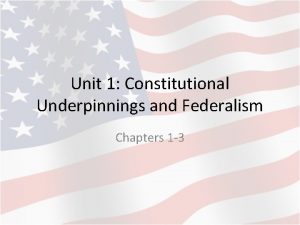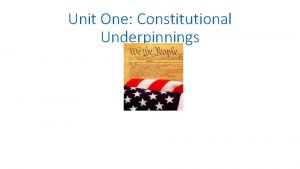Constitutional Underpinnings Part 2 Limited Government Limited government















































- Slides: 47

Constitutional Underpinnings Part 2

Limited Government Limited government: dilemma of wanting a more effective government, but also a limited government that did not become tyrannical. A. Constitutional government: govt. has only those powers listed in Const. B. Bill of Rights as a safeguard against possible tyranny from a new, strong, distant government. Little fear of state govts, but great fear of national govt. Amendment 10 reflects view that states would have substantial powers: central govt. could exercise only those powers delegated to it by the Const. States would have all else. Free elections, but potential of majority faction ---> Madison's "auxiliary precautions. "

Judicial review. A. Power of courts to strike down laws or governmental actions. B Not explicitly provided for in Const. , but Const. written in broad terms ---> need for interpretation ---> this most logically falls to the courts. C. Established by Marbury v. Madison, 1803: 1. Facts of case: the end of Federalist control of govt. and appointment of the "midnight judges, " including Marbury ---> Jefferson ordered Madison to not deliver commissions to these judges --->Marbury's request for a writ of mandamus (under Sect. 13 of Jud. Act. of 1789) from the Supreme Court to order the delivery of his commission. 2. Decision of Marshall and the Court: section 13 of Judiciary Act of 1789 enabling the Court to issue a writ of mandamus through original jurisdiction in this type of case was unconstitutional.

Judicial Review 3. Analysis. a. Marshall ruled that the Court did not have the authority to issue the writ, but he paradoxically increased its power by establishing judicial review when the Court struck down section 13. b. Jefferson couldn't complain because the midnight judges didn't receive their appointments, but he fumed because his enemy, Federalist John Marshall, increased the power of the Court. Effects of judicial review: citizens can challenge constitutionality of laws in court by initiating lawsuits (example: Gideon v. Wainright, 1963) litigation has become an important way of making public policy. Hip Hughes video- Marbury v Madisonhttps: //www. youtube. com/watch? v=YFFZYJ zv 8 -I&t=36 s Chief Justice John Marshall



Changing the Constitution informally A. Const. a framework ---> details to be filled in later. B. Due to difficulties of formally changing Const. , informal ways developed: 1. Acts of Congress (e. g. , Judiciary Act of 1789). 2. Judicial rulings (e. g. , Plessy v. Ferguson, Brown v. Board, Texas v. Johnson, Lawrence v. Texas). 3. Presidential actions (e. g. , police actions since WWII, executive privilege, impoundment). Jefferson believed each generation might need new Const. This hasn’t occurred because of the informal changes that have allowed the Constitution to adapt to changing times.

Changing the Constitution formally, i. e. adding Amendments. A. Legacy of Articles: Unanimous vote to amend ----> impractical ---> desire to make process easier, but not too easy. B. Reasons for recent popularity of proposing Amendments (e. g. , balanced budget, D. C. statehood, ERA). 1. Dissatisfaction by interest groups with court decisions, e. g. , flag burning decision 2. Gridlock in Congress.

Changing the Constitution formally, i. e. adding Amendments. C. Process of amending reflects federal system. 1. Proposal. a. 2/3 vote from both houses of Congress (all done this way). No presidential veto possible. b. Const. convention called by Congress at request of 2/3 of states --->serious implications and fears of such a gathering: 1) Never used before. 2) Fear of "runaway" convention that might get out of hand implement wholesale changes in the Const. 3) Disturbing questions: Will convention stick to only the matter at hand? Will it take on other issues? Who gets to be delegates? How are they selected? How is representation among the states to be determined?

Changing the Constitution Formally, i. e. adding Amendments Ratification: 2 methods. Congress decides which shall be used. a. 3/4 of state legislatures. 1) All but one (21 st) done this way. 2) Most state legislatures ratify w/simple majority, but some require a "supermajority. " (e. g. , 3/5, 2/3, 3/4) b. Ratifying conventions in 3/4 of states. c. Amendment 21 done this way. A more directly democratic way: people elect delegates who state their positions on the proposed amendment. Citizens are in essence casting their votes on the amendment by voting for the appropriate delegates. Time limits for ratification: generally 7 years (exception of ERA).




ORIGINS OF AMERICAN FEDERALISM Federalism: constitutional division of power between the national govt. and state govts. Both get their powers from a Constitution, not each other. II. Reasons for federal system in U. S. A. Unitary system (where a central government rather than a constitution delegates power) was undesirable -- too reminiscent of British rule. Fear of strong, distant govt. B. Confederate system undesirable -- too reminiscent of Articles. C. Allows unity, but not uniformity -- allows for differences among states. D. More suitable for geographically large nation -- allows for differences among states. E. More suitable for heterogeneous people -allows for differences

Reasons for Federal System in U. S F. More likely to check tyranny: 1. If tyranny occurred in a few states, fed. govt. could prevent its spread to others. (e. g. , Shays' Rebellion) 2. National govt. has only those powers granted to it -- all others belong to states through Amendment 10. -- Cost of checking tyranny is at times inefficiency, but Founders more interested in checking tyranny than in having a strong and effective govt. that could run roughshod over the people's liberties.

Reasons for federal system in U. S G. Frees national govt. to concentrate on truly national matters. H. Frees states from excessive intrusion on strictly state/local matters (but discuss problem of growth of federal mandates, and esp. unfunded mandates). I. Encourages experimentation -- states as "laboratories" (e. g. legalized gambling in Nevada has spread to other states, CA legalization of medical marijuana has been adopted by a few other states) J. Keeps govt. closer to people. Multiple points of access for citizens.


Dual Federalism 1. Prevalent through ~1937. 2. State governments and national government each remained supreme within their own spheres. 3. Powers and policy assignments of the layers of govt. were distinct, as in a layer cake. 4. Suggested that the powers of the national govt. should be interpreted narrowly.

Cooperative (“Marble Cake”) Federalism. 1. Prevalent since ~1937. 2. Mingling of responsibilities between the state and national govt. 3. Sharing of powers and policy assignments, as in a marble cake. 4. Suggests that powers of the national govt. should be interpreted broadly.

New Federalism 1. Shifting of some authority from national govt. back to the states. 2. Associated with Nixon, Reagan, and esp. associated with 104 th and 105 th Republican Congress: “Devolution Revolution” 3. Example: use of block grants in welfare reform bill of 1996.

STRUCTURE OF AMERICAN FEDERALISM I. National powers. National govt. has 3 categories of powers that are delegated to it. Here are the categories of the delegated powers: A. Expressed (enumerated): actually stated in the Const. B. Implied: not stated explicitly, but suggested implicitly. Importance of elastic clause. C. Inherent: not stated explicitly, but held by the national govt. by virtue of its being a national govt. Any govt. is entitled to certain foreign policy powers such as diplomatic recognition, acquiring territory, or defending itself.

STRUCTURE OF AMERICAN FEDERALISM State powers: reserved II. A. Amendment 10 states that any powers not granted to the national govt. are reserved for the states. B. Examples: establishing voting requirements, running elections, licensing professionals, protecting community health, establishing a vehicle code.

STRUCTURE OF AMERICAN FEDERALISM III. Concurrent powers. A. Granted to Congress, but not denied by Const. or courts to the states ---> held by both national and state govts. B. Examples: taxing, borrowing, establishing court system, establishing law enforcement agencies. C. Questions of fed. /state authority are decided by courts.



STRUCTURE OF AMERICAN FEDERALISM IV. National supremacy (Article VI): national govt. supreme in case of conflict.

STRUCTURE OF AMERICAN FEDERALISM V. Obligations of national govt. to the states A. Guarantee each state a republican form of govt. B. Protect each state against invasion or domestic violence. C. Grant new states the same rights as other states.

STRUCTURE OF AMERICAN FEDERALISM VI. Obligations of state govts. A. Full faith and credit clause: each state must honor the public acts, records and legal proceedings of other states, e. g. , birth certificates, marriages, debts. 1. Four states (MA, VT, IA, CT) have legalized same-sex marriages. 2. However, in the 1990 s Congress passed the Defense of Marriage Act, which allowed each state to define marriage, and in effect not recognize gay marriage if the state defined marriage as the union of a man and a woman. B. Privileges and immunities clause: each state must grant to citizens of other states the same rights and privileges that they grant to their own citizens, i. e. , states cannot unreasonably discriminate against citizens of other states. C. Extradition: Governors must return suspects to the states in which they allegedly committed their crimes. D. Interstate compacts require consent of Congress.

III. Triumph of nationalist approach: Mc. Culloch v. Maryland, 1819 A. Maryland attempted to tax a branch of the Bank of the U. S. : 1. It argued that taxing was one of its reserved powers. 2. In addition, it argued that the Bank was unconstitutional, anyway. B. The Court's decision (under Marshall): 1. Need for a more flexible interpretation of the Const. so that it would endure -> Bank was "necessary and proper" ---> establishment of implied powers. 2. "Power to tax involves power to destroy" --> states clearly not free to destroy the national govt. ---> establishment of national supremacy.

IV. Sources of National Strength. A. Elastic clause: Congress can pass laws “necessary and proper” to carry out expressed powers. B. War powers. C. Commerce clause: virtually anything is interstate or foreign commerce Congress can regulate virtually anything. D. Power to tax and spend for the “common defense and the general welfare. ” 1. While Congress cannot technically legislate on everything, it can spend funds on virtually everything. 2. States don't have to accept federal money, but if they do, they must follow federal guidelines (e. g. , fed. highway funds can be denied if a state’s alcohol purchasing age is less than 21, fed. education funds can be denied if states do not comply w/No Child Left Behind Act) -- Federal "strings" attached to funding are ways in which the federal govt. can get its way on things. E. Preemption of state laws by fed. courts if laws in conflict w/Const. or fed. laws. F. Imposition of federal mandates (some unfunded) on states

V. Recent Developments. A. Evolution towards greater federal control throughout most of 20 th century. B. Nixon's "New Federalism: " returning some power back to states. Also favored by Reagan, both Bushes, and Republican Party in general C. Republican victory in cong. elections of 1994 ---> Contract with America and devolution of power back to states: 1. Unfunded Mandates Reform Act of 1995 restricted future unfunded mandates. 2. Use of block grants to replace categorical grants. 1996 welfare reform bill that ended welfare as fed. entitlement. (Save details of this bill for tomorrow) Repeal of 55 m. p. h. speed limit.

V. Recent Developments E. Supreme Court actions consistent with devolution: 1. 2. 3. 4. 5. Struck down Gun Free School Zones Act in 1995 in US v. Lopez: Congress overextended itself when it linked gun control laws to the interstate commerce clause of the Constitution. Struck down part of the Violence Against Women Act in US v. Morrison (2000), saying that rape victims could not sue their attackers in federal court because it was up to the states – not Congress – to give such help to women victimized by violence. Again, the Court said that the Congress overextended itself with the use of the interstate commerce clause in passing the Act. Struck down Religious Freedom Restoration Act in 1993: This act had restricted the power of the states to regulate religion -> this ruling gave states greater authority to regulate religion. Struck down Brady Act in 1997 that required local law enforcement agencies to do background checks on gun buyers. Upheld an Indiana law that required photo ID for voting (Crawford v. Marion County Election Board and Indiana Democratic Party v. Rokita, 2008)

FEDERALISM AND FEDERAL GRANTS • As national govt. has grown more powerful, it has used state and local govts. to administer programs that are federally funded ---> development of federal grants to state and local govts. Dollar amounts of these have consistently risen in last several decades, though there has been variation in grants as a percentage of federal expenditures.

Purposes of Fed. Grants A. Reduces growth of fed. bureaucracy -- fed. govt. simply provides money to states and has states run the programs (under fed. guidelines, of course). B. Supplies state and local govts. w/needed revenue. C. Establishes minimum fed. standards in important areas (air quality, water quality) D. Equalizes resources among rich and poor states.

Types of Fed. Grants A. Categorical. 1. For specific programs (e. g. , roads, airports, housing, bilingual education). 2. National govt. agrees to pay a portion of the costs for these, and states pick up the balance --> these sometimes called "formula grants" because grants are offered under a payment formula (e. g. , 80%-20%). 3. States don't have to accept these, but if they do they must comply w/fed. standards.

Types of fed. grants. Block. 1. Granted to support a collection of general programs (e. g. , urban development, transportation) ---> more state leeway in spending of the money. 2. Associate these w/104 th and 105 th Republican Congress and devolution of power back to states.

The Politics of Federal Grants • • Democrats have generally favored greater funding, but with more “strings” associated with categorical grants. Republicans have generally favored less funding, but with fewer “strings” associated with block grants. Welfare is an example of this: End to entitlement status of AFDC and federal guarantee of welfare checks with passage in 1996 of Personal Responsibility and Work Opportunity Reconciliation Act (Welfare Reform Act of 1996) Welfare block grants therefore replaced the welfare categorical grants. Even as a block grant, the Welfare Reform act involved federal “strings: ” No fed. funds go to recipients who have not worked within 2 yrs. No fed. funds go to recipients who have received fed. money > 5 yrs. States must spend at least 75% of what they had previously spent on welfare – this to avoid the “race to the bottom. ”

The Politics of Federal Grants An exception to the “fewer strings” approach by the Republican Party is its support of the No Child Left Behind Act of 2002: In order to receive federal funds for education, states must: 1. Adopt subject matter standards 2. Test all students in grades 3 -8 on those standards 3. Identify low-performing schools based upon that testing 4. Require low-performing schools to develop improvement plans 5. Allow parents of students in such schools that do not improve to transfer to other public schools


FEDERAL MANDATES • • • Mandate: a federal order imposed upon states. Examples: Americans with Disabilities Act. Various environmental acts, e. g. , Clean Air Act, Clean Water Act Individuals with Disabilities Education Act

FEDERAL MANDATES Purposes: to meet a goal of the federal government

Mandates and Their Impact upon the states: • Financial burdens, esp. with unfunded mandates, e. g. , ADA has imposed large costs upon states as they make “reasonable accommodations” for the disabled. • State complaints about federal heavy-handedness, e. g. , if a state does not devise a plan and pay for the requirements of the Clean Air Act of 1990, the federal government will impose its own plan upon the state. • State complaints about federal blackmail, e. g. , if a state doesn’t comply with the Clean Air Act standards, federal funds can be withheld in other programs.


Republican Response to Mandates: *Unfunded Mandates Reform Act of 1995 (part of Contract w/America) restricted future unfunded mandates *Required CBO to analyze impact of unfunded mandates on states. *Requires separate congressional vote on bills that impose unfunded mandates. B. This is another example of the Devolution Revolution associated with the 104 th Congress.

POLITICS OF AMERICAN FEDERALISM Nonconstitutional reasons for triumph of nationalist approach. A. Growth of U. S. in size and population ---> large problems only national govt. could handle. B. Problems tend to be more national (and even international) in scope, e. g. , pollution, crime, global economy. C. Improved communication and transportation -- Washington D. C. not so far away. D. Historical developments (New Deal, WWII, Great Society) created huge bureaucracies and constituencies to support a strong fed. govt. Once federal programs are started, they are difficult to end because of the political support that has developed for them.

Backlash against big government E. Reduction of Great Society-style fed. aid to cities, and restoration of principle that states should take on more responsibilities: 1. Reduction of categorical grants. 2. Increased use of block grants. 3. Reduction of fed. regulations, e. g. granting of waivers to states that want to experiment with welfare reform. 4. 1996 welfare reform bill that ended welfare as federal entitlement. 5. Restrictions on future unfunded mandates as part of Contract with America.

Effects of New Federalism and Devolution Revolution: a mixed bag. Clinton declared in 1996 that “The era of big government is over. ” Supporting evidence of this: -Welfare reform bill, -Repeal of 55 m. p. h. limit -Restrictions on future unfunded mandates -More block grants/less categorical grants. Tax cuts under both Clinton and Bush 43
 New federalism
New federalism Philosophical underpinnings of nursing
Philosophical underpinnings of nursing Perfusion vs diffusion limited
Perfusion vs diffusion limited Anarchy limited or unlimited
Anarchy limited or unlimited Limited government examples
Limited government examples Limited government definition
Limited government definition Limited government definiton
Limited government definiton Limited government
Limited government Limited government examples
Limited government examples Monarchy pictoword
Monarchy pictoword What does unlimited government mean
What does unlimited government mean Is india a limited or unlimited government
Is india a limited or unlimited government Popular sovereignty
Popular sovereignty Define limited government
Define limited government Republicanism definition government
Republicanism definition government Limited government
Limited government Government unit 3 lesson 3
Government unit 3 lesson 3 Meaning of limited government
Meaning of limited government Limited government
Limited government Unlimited government
Unlimited government Define limited government
Define limited government What is unlimited government?
What is unlimited government? What does limited government mean
What does limited government mean Six principles of the constitution
Six principles of the constitution Va plan nj plan great compromise
Va plan nj plan great compromise Constitutional convention 1787
Constitutional convention 1787 Executive branch superhero
Executive branch superhero Right to constitutional remedies
Right to constitutional remedies Constitutional growth delay
Constitutional growth delay Conclusion of french revolution
Conclusion of french revolution Constitutional convention compromise
Constitutional convention compromise Chapter 3 section 3 change by other means
Chapter 3 section 3 change by other means Gitlow v new york constitutional question
Gitlow v new york constitutional question Constitutional convention article 5
Constitutional convention article 5 Constitutional act of 1791
Constitutional act of 1791 Constitutional powers
Constitutional powers Characteristics of constitutional democracy
Characteristics of constitutional democracy Constitutional superheroes examples
Constitutional superheroes examples Why was hazelwood v kuhlmeier important
Why was hazelwood v kuhlmeier important Constitutional pursuit answer sheet
Constitutional pursuit answer sheet Constitutional convention begins
Constitutional convention begins Constitutional republic symbol
Constitutional republic symbol Max planck encyclopedia of comparative constitutional law
Max planck encyclopedia of comparative constitutional law Creating the constitution answer key chapter 2 section 4
Creating the constitution answer key chapter 2 section 4 Annapolis convention apush
Annapolis convention apush Lesson 1 - the constitutional convention
Lesson 1 - the constitutional convention Constitutional act of 1791
Constitutional act of 1791 Iupac name of alkane
Iupac name of alkane
